And We Have a Winner!
Fillet disc cross show bike update –
This is the frameset I brought to NAHBS and displayed in the raw. Once I got it home from the show I hung the kit on it and started riding it hard. The riding and testing showed that while it rode nice and smooth there was a funny behavior when braking hard and turning that I wasn’t fond of. The loads were a bit too high for the first fork I built for it and it had this funny ‘twitch’ in the steering when diving hard into a turn and braking. So………..it was time to make a change. I first made the original fork stiffer with external ribs just to see what would happen and while it was better I still didn’t love it.
Next I built another fork with a different crown and straight blades. This fork worked better under braking but it had two downsides – it was harsh riding and I just didn’t like the look. It wasn’t truly bad in either way but I didn’t love it so it was on to round three.
The 3rd fork used the same type crown as the first but different blades. These blades have a shorter taper and by bending them just right I could cut off more of the bottom of the blades than the top (to get it to the proper length) so I had a larger diameter down where the brake loads were. This fork has turned out to be the ‘have your cake and eat it too’ deal. Smooth ride, great braking stability when going straight or diving into a tight corner on a loose surface, good looking and more than light enough. We have a winner. I’m pumped by how it rides.
Now it’s time to pull the parts off it and send it off to JB for some paint to get it ready for race season this fall. Here are a few photos of the bike with it’s 3rd and final generation fork. Here are a few photos of it all built up with fork 3.
Dave
Share this Article:
14 responses to “And We Have a Winner!”
Leave a Reply
You must be logged in to post a comment.
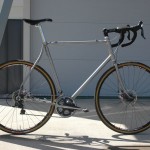
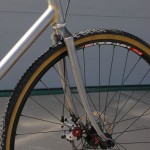
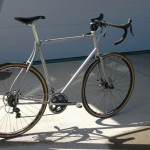
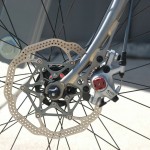
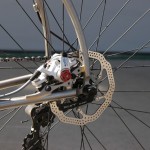




Dave –
That’s cool. But I have a question. How can you ride a bike without paint on it? I mean, I understand that this doesn’t effect performance at all, but how do you know which kit to wear so that it all matches? It’s probably not a huge deal on the road, but what about when you’re sitting next to at the coffee shop drinking overly priced, non-fat, caffeinated drinks? Coming from Boulder this just seems impossible! How would one pretend to be a pro with an unpainted bike? So many questions.
Again, you show that you are a true wizard.
Congrats on the results of your fork R&D. Speaking of forks, what is your impression on the ride quality of the older French style of forks? i.e the forks where the bend/rake is at the very bottom, near the front hub. To me, the old French style forks seem to ride really smooth on gravel roads, but maybe its just my imagination.
Yep – I’ve been trimming mine about up to the 14mm OD mark.
Glad you are way ahead of the curve on disc brakes. Can’t wait to get my disc equipped cross bike next year.
Sweet.
I love reading R&D type entries about bikes. Any chance of seeing the other forks?
I’m really impressed by how much you test your products before offering them for sale.
D — Good work and I enjoyed reading that. Two questions:
1). Do you think the fork that worked was particular to your height and weight, or do you think a similar fork will work with discs across the board?
2). On the rear-disk, I seem to recall you hand-cut the dropout or attachment. Will you be doing that for all bikes, or having a design of yours CNC’s, or using one of the other well known dropouts? Just curious.
Yrs, Eric
I apologize – for some reason I wasn’t notified that there were comments to address. So ……………. yes tightening the radius of the curve and concentrating it toward the bottom of the blade can give a smoother ride. The downside can be in steering feel and precision. The blades can get soft enough that when steering tightly one blade flexes a lot more than the other and the fork ends up twisting. Not a good thing for high speed steering feel. So it’s all a tradeoff and compromise.
dave
Yes and no……….the straight blade fork still exists but I haven’t taken any photos of it. Not much to see frankly – just straight blades. The 3rd fork is the one shown in the last post and it reused the steerer/crown/disc tab of the original fork. I removed the blades and reused the rest of the stuff to save some time and money. So you’ve seen #1 and #3 and number two is hanging on a hook. If you’d really like I could snap a photo but it’s a bit of a moot point and I’ll never use it again.
Time to paint this thing!
dave
Hello Sir,
Good questions. Here are a few answers/responses –
1) to a certain extent yes – I think fork #3 is better suited to my size and weight. I do think that it would work very well for some lighter folks too. For much lighter riders I’d take a bit of weight/stiffness out with the blades and their taper and wall.
2) I have a new version of the Triple F that will be going into production this summer that will deal with a disc brake in a slightly new way in the rear. Lighter, more simple and easy to build with. So no I won’t be hand cutting disc tabs. I’ll be perfectly happy to not do a lot more of that!
Thanks again,
Dave
Nice!
How are the cables routed, particularly the one for the rear disc?
Thank you
The routing is pretty straight forward and simple. The rear cable travels down the underside of the down tube and then over the top of the BB shell and on top of the chainstay to the brake. Nice tidy run and short sections of housing keep it very firm.
dave
Late to the party but, Dave, that bike just looks ‘right’!
Cheers!
Hi Dave,
There has been a recent thread on the framebuilder’s email list that got me thinking about all of your work with disc brakes on road and cross bikes. There was talk of blades un-raking themselves, tapered steel blades not being appropriate for disc forks, and what not. From your blog I gather that you now have a full season of riding on both road and cross bikes. So how have your forks been holding up? I am guessing you haven’t had these problems? When are you planning to add discs as an option? I have been very impressed by your thorough R&D process so I am curious to hear your take. Thanks much for any info!
-Jason